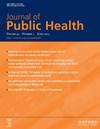Prospective associations of screen time at age 2 with specific behavioral subscales at age 3: a cohort study
IF 3.6
4区 医学
Q1 PUBLIC, ENVIRONMENTAL & OCCUPATIONAL HEALTH
引用次数: 0
Abstract
Background We aim to discover which, if any, of the subscales of internalizing and externalizing behavioral problems at age 3 are still associated with screen time (ST) at age 2 after adjusting for behavioral problems scores at age 2. Methods This study was conducted under the Tohoku Medical Megabank Project Birth and Three-Generation Cohort Study. Information was gathered prospectively, with 7207 mother–child pairs included in the analysis. Children’s ST was categorized in hours a day at age 2 (<1, 1-<2, 2-<4, ≥4). We assessed children’s behavioral problems using the Child Behavior Checklist for Ages 1½–5 (CBCL) at ages 2 and 3. ‘Having behavioral problems’ was defined by them being within a clinical range for internalizing behaviors (withdrawn, somatic complaints, anxious/depressed and emotionally reactive) and externalizing behaviors (attention problems and aggressive behaviors) at age 3. Continuous scores on each of the behavioral problem scales at age 2 were used as covariates. Results Greater ST for children at age 2 was associated with specific subscales for emotionally reactive and aggressive behaviors at age 3. Conclusions This study found that ST is prospectively associated with some behavioral scales but not others.2 岁时的屏幕时间与 3 岁时特定行为分量表的前瞻性关联:一项队列研究
背景 我们旨在发现,在调整 2 岁时的行为问题得分后,3 岁时的内化和外化行为问题的哪些分量表(如果有的话)仍与 2 岁时的屏幕时间(ST)相关。方法 本研究是在东北医学大型数据库项目出生和三代队列研究中进行的。研究采用前瞻性方法收集信息,共有 7207 对母子参与分析。儿童两岁时的ST以每天小时数分类(<1、1-<2、2-<4、≥4)。行为问题 "的定义是儿童在 3 岁时的内化行为(孤僻、躯体不适、焦虑/抑郁和情绪反应)和外化行为(注意力问题和攻击行为)处于临床范围之内。2 岁时各行为问题量表的连续得分被用作协变量。结果 2 岁时儿童的 ST 增加与 3 岁时情绪反应和攻击行为的特定分量表相关。结论 本研究发现,ST 与某些行为量表有前瞻性关联,但与其他行为量表无关。
本文章由计算机程序翻译,如有差异,请以英文原文为准。
求助全文
约1分钟内获得全文
求助全文
来源期刊

Journal of Public Health
医学-公共卫生、环境卫生与职业卫生
CiteScore
7.40
自引率
2.30%
发文量
120
审稿时长
6-12 weeks
期刊介绍:
Previous Title Zeitschrift für Gesundheitswissenschaften, Previous Print ISSN 0943-1853, Previous Online ISSN 1613-2238.
The Journal of Public Health: From Theory to Practice is an interdisciplinary publication for the discussion and debate of international public health issues, with a focus on European affairs. It describes the social and individual factors determining the basic conditions of public health, analyzing causal interrelations, and offering a scientifically sound rationale for personal, social and political measures of intervention. Coverage includes contributions from epidemiology, health economics, environmental health, management, social sciences, ethics, and law.
ISSN: 2198-1833 (Print) 1613-2238 (Online)
 求助内容:
求助内容: 应助结果提醒方式:
应助结果提醒方式:


